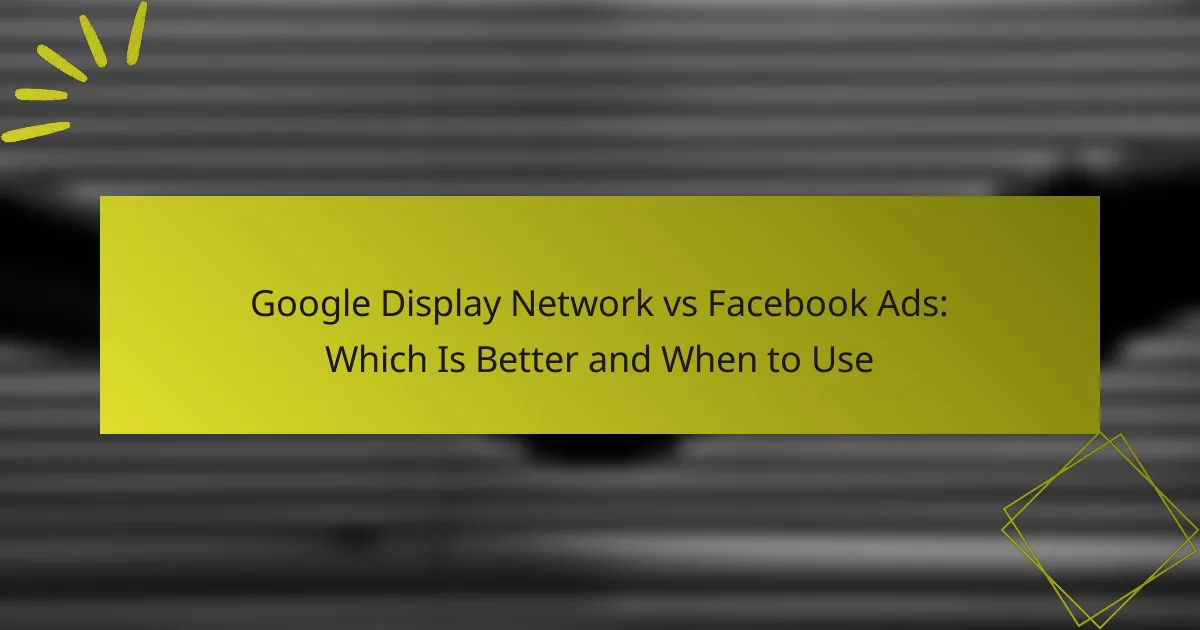Social media platforms provide powerful tools for audience targeting, enabling brands to connect with specific groups based on demographics, interests, and behaviors. By implementing effective engagement strategies and utilizing diverse ad formats, businesses can enhance user interaction and drive conversions, ultimately fostering brand loyalty and achieving marketing objectives.
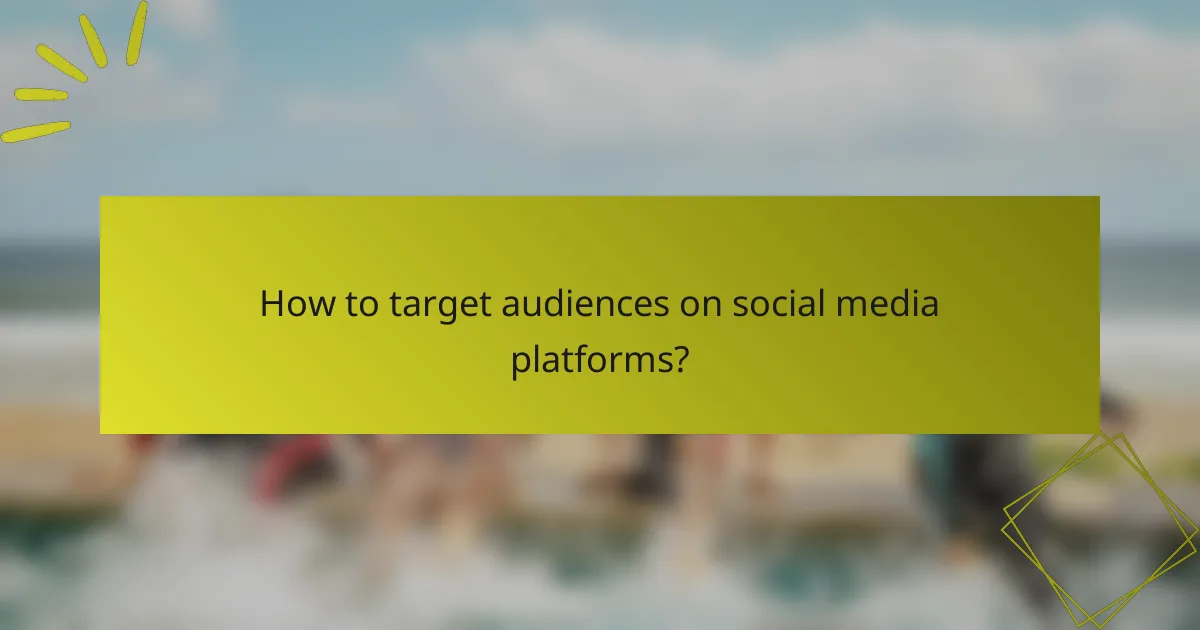
How to target audiences on social media platforms?
Targeting audiences on social media platforms involves identifying and reaching specific groups based on various criteria, enhancing engagement and ad effectiveness. By utilizing demographic, interest-based, behavioral, and custom audience strategies, brands can optimize their outreach and connect with users more meaningfully.
Demographic targeting on Facebook
Demographic targeting on Facebook allows advertisers to reach users based on age, gender, location, education, and more. This targeting is crucial for businesses aiming to connect with a specific audience segment, such as young adults in urban areas or parents with children of certain ages.
To effectively use demographic targeting, consider creating multiple ad sets tailored to different demographics. For instance, a clothing brand might target women aged 18-24 with one ad and men aged 25-34 with another, ensuring that the messaging resonates with each group.
Interest-based targeting on Instagram
Interest-based targeting on Instagram enables brands to reach users based on their interests, activities, and the content they engage with. This method is particularly effective for lifestyle brands looking to connect with users who have shown interest in similar products or themes.
To maximize interest-based targeting, utilize Instagram’s insights to identify relevant interests for your audience. For example, a fitness brand might target users interested in health, wellness, and fitness influencers, ensuring that the ads appear in the feeds of potential customers who are likely to engage.
Behavioral targeting on Twitter
Behavioral targeting on Twitter focuses on user actions, such as tweets, retweets, and engagement patterns. This approach allows advertisers to reach users based on their online behavior, making it possible to target those who have shown interest in specific topics or brands.
To implement effective behavioral targeting, analyze user engagement data to identify trends. For instance, a tech company might target users who frequently tweet about new gadgets or follow technology-related accounts, increasing the likelihood of reaching an interested audience.
Custom audiences on LinkedIn
Custom audiences on LinkedIn allow businesses to upload their own contact lists to target specific individuals or companies. This feature is particularly useful for B2B marketing, enabling brands to reach decision-makers and professionals within their industry.
When creating custom audiences, ensure that your contact list is up-to-date and segmented appropriately. For example, a software company might upload a list of current clients to promote new features, while targeting potential leads with tailored messaging to encourage engagement.
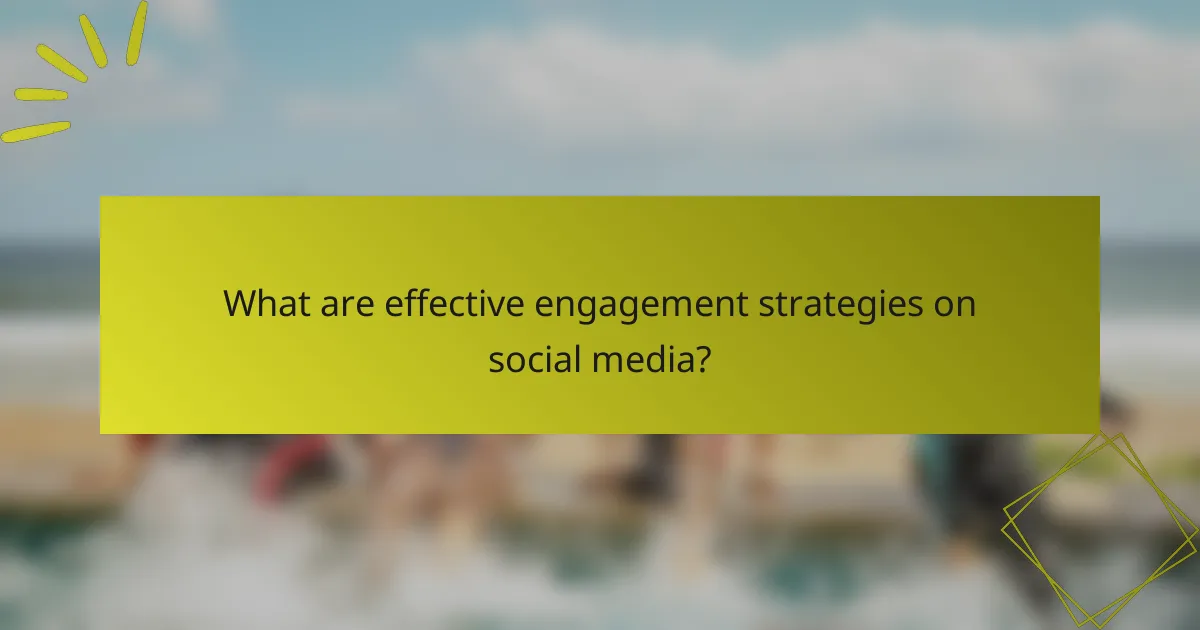
What are effective engagement strategies on social media?
Effective engagement strategies on social media focus on creating interactive and relatable content that resonates with the target audience. Utilizing various formats and features available on each platform can significantly enhance user interaction and brand loyalty.
Interactive content on TikTok
Interactive content on TikTok includes challenges, duets, and user-generated content that encourages participation. Brands can create challenges that users can join, increasing visibility and engagement. For instance, a dance challenge related to a product can go viral, drawing in a wide audience.
To maximize engagement, brands should use trending sounds and hashtags. Regularly engaging with user submissions by liking or commenting can also foster a community feel, encouraging more users to participate.
Live streaming on Facebook
Live streaming on Facebook allows brands to connect with their audience in real-time, creating a sense of urgency and authenticity. This format is ideal for product launches, Q&A sessions, or behind-the-scenes looks, which can drive higher engagement rates compared to standard posts.
To make the most of live streaming, promote the event in advance and encourage viewers to ask questions or share their thoughts during the broadcast. Offering exclusive content or giveaways during the live session can further incentivize participation.
Polls and quizzes on Instagram Stories
Polls and quizzes on Instagram Stories are effective tools for engaging followers and gathering feedback. These interactive features allow brands to ask questions, gauge opinions, or test knowledge, making followers feel involved in the brand’s narrative.
To enhance engagement, keep polls and quizzes light and fun, and relate them to current trends or brand themes. Regularly using these features can help maintain interest and encourage followers to interact with content consistently.

What ad formats are available on major social media platforms?
Major social media platforms offer a variety of ad formats tailored to engage users and drive conversions. Each format has unique features that cater to different marketing goals, such as brand awareness, lead generation, or direct sales.
Carousel ads on Facebook
Carousel ads on Facebook allow advertisers to showcase multiple images or videos within a single ad unit. Users can swipe through the carousel to view different products or features, making it ideal for storytelling or highlighting a range of offerings.
When creating carousel ads, consider using high-quality visuals and concise text for each card. Aim for a clear call-to-action that encourages users to engage with the ad, such as visiting a website or making a purchase. Testing different images and sequences can help optimize performance.
Video ads on YouTube
YouTube video ads come in several formats, including skippable and non-skippable ads, bumper ads, and overlay ads. These formats allow brands to reach users with engaging video content, which can be particularly effective for storytelling and product demonstrations.
To maximize the impact of video ads, keep them concise and focus on delivering the message within the first few seconds. Utilize compelling visuals and sound to capture attention. Consider targeting options based on user interests and demographics to reach the most relevant audience.
Sponsored posts on Instagram
Sponsored posts on Instagram enable brands to promote their content directly in users’ feeds. These ads blend seamlessly with organic posts, making them less intrusive and more engaging for users. Brands can use images, videos, or carousels to showcase their products or services.
When creating sponsored posts, ensure that the visuals are eye-catching and aligned with your brand’s aesthetic. Use relevant hashtags and a strong call-to-action to drive engagement. Monitoring performance metrics can help refine future campaigns and improve targeting strategies.
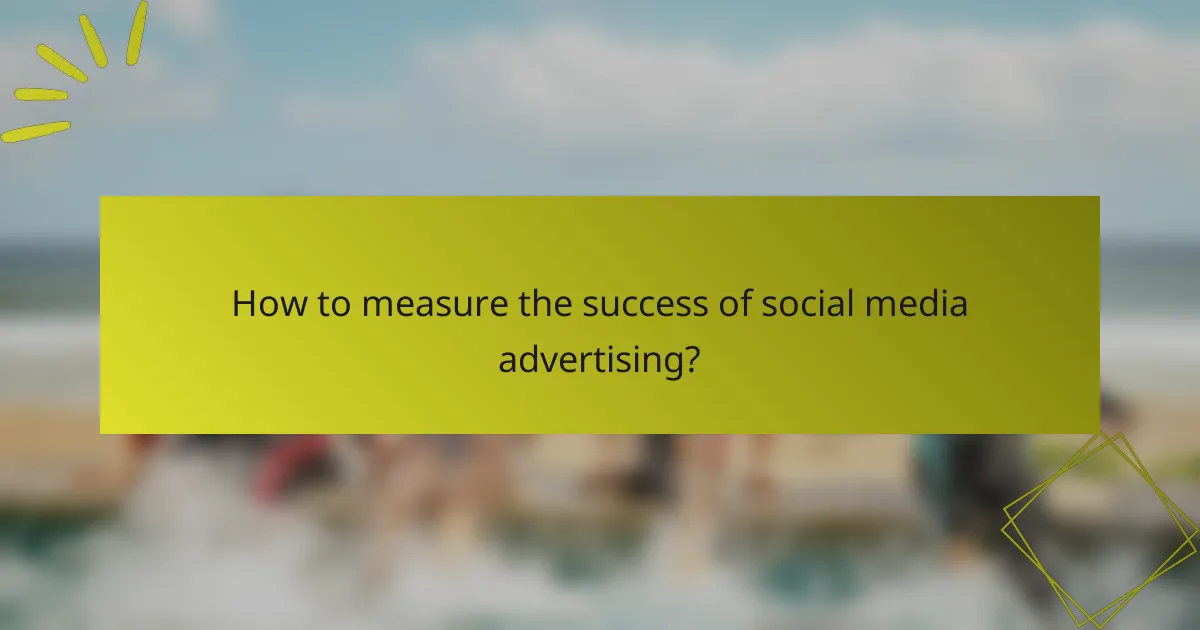
How to measure the success of social media advertising?
To measure the success of social media advertising, focus on key performance indicators (KPIs) such as engagement rates, conversion rates, and return on ad spend (ROAS). These metrics provide insights into how well your ads resonate with the audience and their effectiveness in driving desired actions.
Engagement metrics analysis
Engagement metrics are crucial for understanding how users interact with your social media ads. Key metrics include likes, shares, comments, and click-through rates (CTR). High engagement often indicates that your content is resonating with the audience, while low engagement may suggest a need for content adjustments.
To analyze engagement effectively, track these metrics over time and compare them against industry benchmarks. For example, a CTR of 1-3% is generally considered average for social media ads. Regularly reviewing these metrics can help identify trends and inform future advertising strategies.
Conversion tracking with Google Analytics
Conversion tracking using Google Analytics allows you to measure how many users take specific actions after interacting with your social media ads. Set up goals in Google Analytics to track actions such as purchases, sign-ups, or downloads. This data helps assess the effectiveness of your ad campaigns in driving tangible results.
To implement conversion tracking, ensure that your Google Analytics account is linked to your social media platforms. Use UTM parameters in your ad links to accurately attribute conversions to specific campaigns. Regularly review conversion data to optimize your advertising efforts and improve ROI.
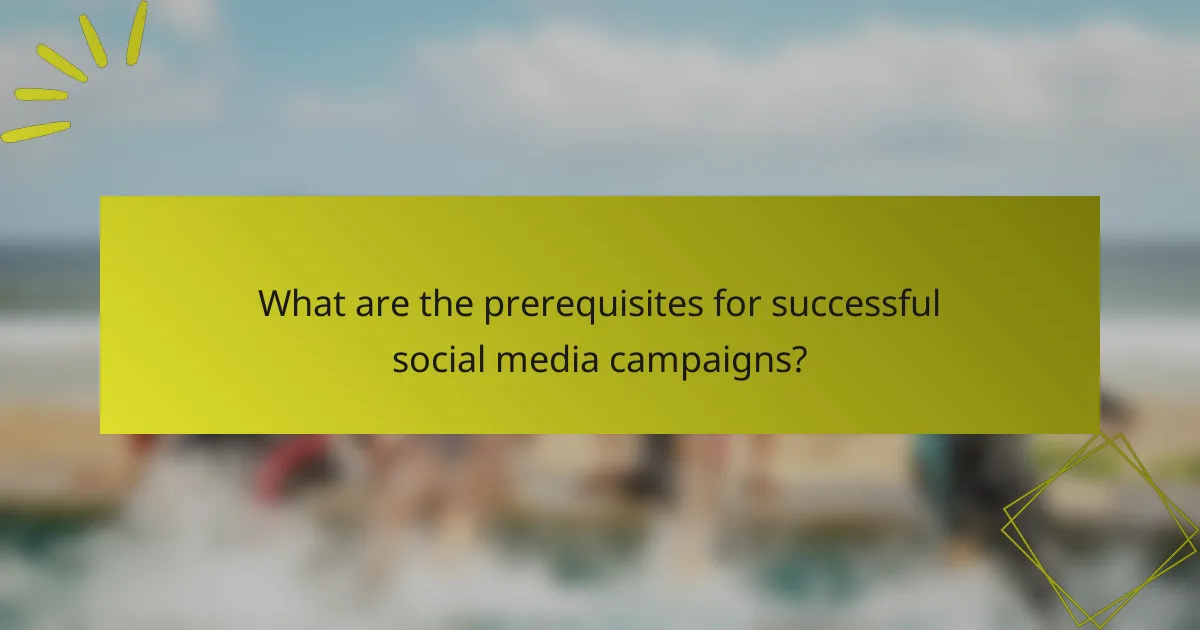
What are the prerequisites for successful social media campaigns?
Successful social media campaigns require a deep understanding of your target audience, clear objectives, and effective engagement strategies. These elements help ensure that your messaging resonates and drives desired actions.
Understanding target audience demographics
Identifying your target audience demographics is crucial for tailoring your social media campaigns. Consider factors such as age, gender, location, interests, and online behavior to create content that appeals to specific groups.
Utilize tools like Facebook Audience Insights or Google Analytics to gather data about your audience. This information can guide your content creation and advertising strategies, ensuring that you reach the right people with the right message.
Setting clear campaign objectives
Establishing clear campaign objectives is essential for measuring success. Determine what you want to achieve, whether it’s increasing brand awareness, generating leads, or boosting sales. Use the SMART criteria—Specific, Measurable, Achievable, Relevant, Time-bound—to define these goals.
For example, instead of a vague goal like “increase engagement,” specify “increase post shares by 20% over the next month.” This clarity will help you focus your efforts and evaluate the effectiveness of your campaign.

How do social media algorithms impact advertising?
Social media algorithms significantly influence advertising by determining which content is shown to users, thereby affecting engagement and ad performance. Advertisers must understand these algorithms to optimize their campaigns and reach their target audiences effectively.
Algorithm changes on Facebook
Facebook’s algorithms prioritize content based on user engagement, relevance, and recency. Changes to these algorithms can drastically alter how ads are displayed, impacting visibility and interaction rates. For instance, a shift towards valuing meaningful interactions may favor posts that generate comments and shares over simple likes.
Advertisers should regularly monitor updates to Facebook’s algorithm to adjust their strategies accordingly. Utilizing engaging visuals and interactive content can enhance ad performance, as these elements are more likely to resonate with users and align with the platform’s focus on engagement.
Additionally, understanding the importance of audience targeting is crucial. Ads should be tailored to specific demographics and interests to maximize relevance, which can lead to improved ad placement and effectiveness. Regularly reviewing audience insights can help refine targeting strategies and improve overall campaign outcomes.

